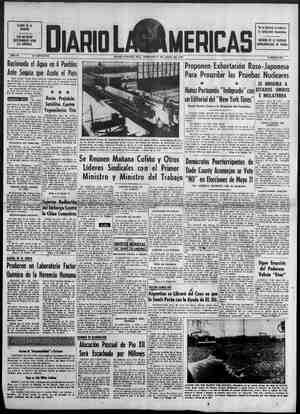Diario las Américas Newspaper, April 21, 1957, Page 24
You have reached the hourly page view limit. Unlock higher limit to our entire archive!
Subscribers enjoy higher page view limit, downloads, and exclusive features.
ANALIDA | queen of coffee Hemisphere Coffee Queen Andlida Alfaro of Panama graces her throne (above) and receives the congratulations of Colombian Queen Gloria Aristizabal (right), MANIZALES was never like this. A sudden influx of visitors doubled the Colombian coffee capital’s po- pulation of 88,893. The newcomers settled for almost any reasonably fiat surface te sleep on after the exhilarating — and exhausting — activities of each of the nine days of its 1957 fair. During the daylight hours — and a good part of the night — they shuttled en masse, with no apparent sign of fatigue, from the Fernando Londojfio Sta- dium to the ski slopes of Mt. Ruiz an hours’ drive away, to Lake Aran- guito, and back to the coliseum. The program had_ everything: bullfights and genuine Texas-style rodeos in the stadium, puppet shows, cockfights, dances, a na- ’ lovely, eighteen-year-old Only one hour’s drive away from the heart of the coffee-producing tone, visitors to the fair enjoy skiing at Mt. Ruis. tional folklore competiton in the the world’s biggest producer; the coliseum, fireworks the like of host country, leader in the “mild” which had never illumined these mountains before, including a spectacular concoction by the Ca- ga Caballer of Valencia, Spain. The Japanese colony of the Cauca Val- ley presented a typical “Night in Japan.” “An Afternoon in Seville” captivated the erowd. One pure- blood Sevillian visitor declared that they were working hard in Spain so that the Spring Fair in his home town might resemble the Manizales production in another ten years. To cap the excitement in this usually austere city perched on its mountain saddle seven thousand feet high, the distinguished Ambas- sador from Spain to Colombia, Dr, German Baisbar; Leif Ohrwall, Mi- nister Plenipotentiary and Special Envoy of Sweden; and Wilfrid V. McCullough, Canadian Chargé @’ Affaires, were entrusted with the ultra-diplomatic and personally de- lectable task of choosing a Queen of Coffee from among fifteen pul- ehritudinous representatives of the American nations that produce the conforting bean. Their unanimous choice was Analida Alfaro of Panama. When the news reached the inner sanctum of the industry’s big promotion agency in New York, the Pan American Coffee Bureau, rumbles of sur- prise and momentary dismay were heard. It had never occurred to them that the prize might go to representative of a country that gtows barely enough cofee for its own use — but the best in the world, in the Boquete district of Chiriqui Province, Panamanians will assure you — over the stand- ard bearers of nations like Brazil, Below: Coffee queens. at Manizales airport: ‘left to right, Magda Mejia Guz man of the Dominican Republic, Irma de la Rosa of Veneructa, Benta cléia Honan of Brazil, Martha de la Espriella of Costa Rica, wianer Andlida Alfaro of Panama, Merceditas Espinosa of México, Sonia Magaiia of Ei Salvador, Lila Bendata of Nicaragua, PAG. 10 HEMISPHERE ay Reprinted from AMERICAS, monthly magazine published by the Pan American Union ia English, Spanish and Portu- guese, varieties that go inte the best blends; or El Salvador, which de. rives 85 per cent of its foreign ex- ehange from coffee sales. They had apparently forgotten that in demo- cracies queens are selected on the basis of beauty’ and charm, not commercial or political considera- tions. But the judges had not for- gotten, and the roars of the crowd in Manizales left no doubt that they had rendered a popular ver- dict. Manuel Mejia, General Manager of the National Federation of Cof- fee Growers, crowned the queen, Dr. Antonio Alvarez Restrepo, a former Minister of Finance and ex- director of the local paper La Patria ,made it official and thoroughly Colombian by deliver- ing an eloquent oration that neg- lected none of the virtues of Si- mon Bolivar’s ideals of Hemisphere union or of any of the charming candidates for royalty. Export and yietd-per-acre data are all very well, but Miss Alfaro had some interesting statistics of her own to display: 124 pounds sveltely distributed over five feet and seven inches. (After the festi- vities, she admitted she hadn’t step- ped on a scale for days, knowing the terrific pace had slimmed her down more.) Colombians needn’t have felt too badly about it all anyway, for Ana- llida’s father Antonio, an engineer, hails from Cartagena. At home ia Candidates for coffee royalty ride floats in parade through streets of Colombian coffee capital Panama, Analida devotes herself to art and flower arrangements and embroiders her own dresses (she herself trimmed the one she wore at the coronation, a white lace gown adorned with pearls). She swims in the family pool and plays volley ball enthusiastically. She is crazy about all kinds of pies, cakes, and candy, but you’d never know it by looking at her. She graduated from a commercial course in Pa- nama and went on to study at Marymount College in Tarrytown in New York, Returning to her isthmian home from Manizales, Analida scarcely caught her breath befere she was swept up in a new round of fiestas as queen of the local pre-Lenten Carnival. She will spend Pan Ame- rican Week, April 7-14 in the Unit- ed States as guest of the Pan Ame rican Coffee Bureau, with a recep- tion on the official Coffee Day, April 9, at the Pan American Union, The Coffee Bureau, established in 1937 by the Latin American producing countries to educate the U. S. public to drink more coffee, naturally takes the business serb ously. Imports of the bean from Latin America to the United States alone last year were worth $l, 300,000,000, and in 1955 this ve ‘SUNDAY, APRIL 21, 1957 .
